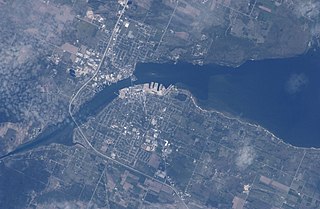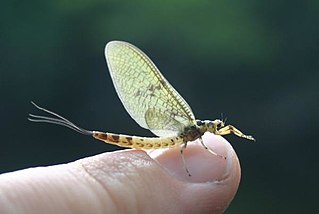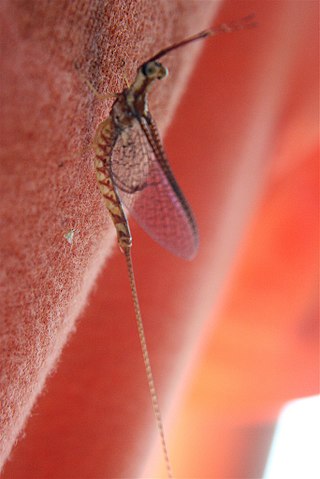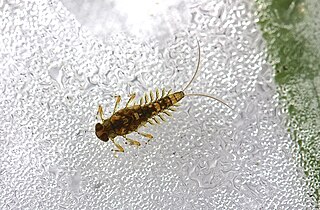
Mayflies are aquatic insects belonging to the order Ephemeroptera. This order is part of an ancient group of insects termed the Palaeoptera, which also contains dragonflies and damselflies. Over 3,000 species of mayfly are known worldwide, grouped into over 400 genera in 42 families.

Sturgeon Bay is an arm of Green Bay extending southeastward approximately 10 miles into the Door Peninsula at the city of Sturgeon Bay, located approximately halfway up the Door Peninsula. The bay is connected to Lake Michigan by the Sturgeon Bay Ship Canal. The Potawatomi name for Sturgeon Bay is "Na-ma-we-qui-tong".

Ephemeridae is a family of mayflies with about 150 described species found throughout the world except Australia and Oceania.
Limnoforming is the process of manipulating the physical or chemical properties of a body of water by introducing organisms which facilitate higher level biological activity, thus impacting the overall ecology of a given body of water, and eventually adjacent ecosystems.

Hexagenia limbata, the giant mayfly, is a species of mayfly in the family Ephemeridae. It is native to North America where it is distributed widely near lakes and slow-moving rivers. The larvae, known as nymphs, are aquatic and burrow in mud and the adult insects have brief lives. They are often referred to as fish flies around the Great Lakes as they tend to cause the areas around water to smell like rotten fish.

Hexagenia atrocaudata is a species of common burrower mayfly in the family Ephemeridae. It is found in North America.
Isonychia arida is a species of brushlegged mayfly in the family Isonychiidae. It is found in North America.

Heterocloeon curiosum is a species of small minnow mayfly in the family Baetidae. It is found in North America.
Leucrocuta petersi is a species of flatheaded mayfly in the family Heptageniidae. It is found in North America.

Drunella grandis is a species of spiny crawler mayfly in the family Ephemerellidae. It is found in North America.
Heptagenia solitaria is a species of flatheaded mayfly in the family Heptageniidae. It is found in southwestern and northern Canada, and the western United States.
Arthroplea bipunctata is a species of flatheaded mayfly in the family Arthropleidae. It is found in North America.
Arthroplea is a genus of flatheaded mayflies in the family Arthropleidae. There are at least two described species in Arthroplea.

Paraleptophlebia guttata is a species of pronggilled mayfly in the family Leptophlebiidae. It is found in southeastern, northern Canada, and the eastern United States.
Isonychia sicca is a species of brushlegged mayfly in the family Isonychiidae. It is found in Central America and North America. In North America its range includes southeastern Canada, and all of Mexico.
Siphlonurus typicus is a species of primitive minnow mayfly in the family Siphlonuridae. It is found in North America.
Ameletus vernalis is a species of combmouthed minnow mayfly in the family Ameletidae. It is found in southwestern Canada and the western United States.

Cinygmula subaequalis is a species of flatheaded mayfly in the family Heptageniidae. It is found in southeastern, northern Canada, the eastern United States, and Alaska.

Acentrella nadineae is a species of small minnow mayfly in the family Baetidae. It is found in the eastern United States.
Rhithrogena flavianula is a species of flatheaded mayfly in the family Heptageniidae. It is found in North America.









